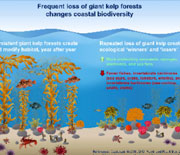Research News
Long-term research offers new insights into coastal biodiversity
October 30, 2018
Find related stories on NSF’s Long-Term Ecological Research program site.
How would increasingly frequent ocean storms affect the biodiversity of undersea kelp forests?
Researchers at the University of Virginia (UVA) and the University of California, Santa Barbara, report that more frequent storms could dramatically change the sea life along the California coast.
The findings appear this week in the journal Ecology.
“The frequency of disturbance was the most important factor influencing kelp forest biodiversity,” said lead researcher Max Castorani, an environmental scientist at UVA. “The severity of disturbance played a more minor role.”
Long-term research important
“It’s significant that the severity and the frequency of disturbances influence kelp bed communities in different ways,” said David Garrison, a director of the National Science Foundation’s (NSF) Long-Term Ecological Research (LTER) program, which funded the study. “We need long-term research to predict what kelp bed communities will look like in the future, and what ecosystem services, such as fisheries, they will be able to provide.”
The experiment was conducted at the NSF Santa Barbara Coastal LTER site, one of 28 such NSF LTER sites across the U.S. and around the world.
The study is one of the few long-term experiments to look at how kelp forests — major marine habitats around the world — could change over time if predictions play out as scientists expect.
Forecasts indicate that storm frequency and severity will increase, as is already happening in many coastal regions.
Nine-year view of a kelp forest
The researchers counted and measured more than 200 species of plants, invertebrates and fish in kelp forests off Santa Barbara every three months over a nine-year period.
They found that disturbances in which kelp forests were experimentally cut back and reduced year-after-year, as happens during severe winter storms with large waves, resulted in a doubling of smaller plants and invertebrates (algae, corals, anemones, sponges) attached to the seafloor.
However, the disturbances also resulted in 30 to 61 percent fewer fish and shellfish, such as clams, sea urchins, starfish, lobsters and crabs.
“The results surprised us because we expected that a single severe event would result in big changes to kelp forest biodiversity,” Castorani said. “Instead, the number of disturbances over time had the greatest impact. Frequent disturbances suppressed the recovery of giant kelp, with consequences for the surrounding sea life.”
Life in the kelp understory
The largest of all algae, giant kelp grows up to 100 feet from the seafloor toward the ocean surface, creating a dense canopy — much like a forest on land — that provides shelter to organisms in deeper waters and on the sea floor.
When that ocean forest is destroyed by a large storm, the “understory” becomes bright with sunlight but less complex and productive, affecting the balance of species.
It’s usual for that to happen when large offshore storms drive destructive waves toward the coastline, said Castorani, and kelp forests normally rapidly recover. But a greater frequency of storms hampers that recovery, eventually resulting in a vastly altered marine ecosystem.
Ecological winners and losers
The repeated loss of giant kelp creates ecological winners and losers. Understory creatures — seaweeds, sponges, anemones and sea fans — are more likely to thrive, while commercially and recreationally valuable fish, crabs, lobsters, whelks and clams decline.
Castorani said the study demonstrates the value of long-term ecological research for understanding environmental change as it happens. It’s like viewing a film of the environment, he said, rather than a snapshot that captures only a moment in time.
“Much of the focus of prior research has been on the response to a single event,” Castorani said, “but this experiment shows the importance of studying repeated disturbances over many years.”
—
Cheryl Dybas,
NSF
(703) 292-7734 cdybas@nsf.gov
—
Fariss Samarrai,
UVA
(434) 924-3778 fls4f@virginia.edu
-
Frequent loss of giant kelp forests changes coastal biodiversity, as this infographic shows.
Credit and Larger Version -
With fronds from the seafloor to the surface, giant kelp offers refuge to fish like these halfmoons.
Credit and Larger Version -
Giant kelp is the largest kelp species; it grows along many temperate coastlines worldwide.
Credit and Larger Version -
An NSF LTER scientist identifies understory seaweeds in a kelp forest near Isla Vista, California.
Credit and Larger Version -
A bird’s eye view of a dense giant kelp forest near Santa Barbara, California.
Credit and Larger Version
_f.jpg)




